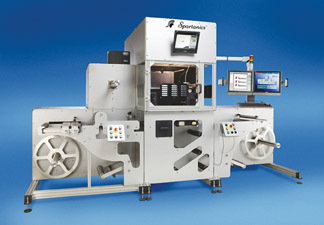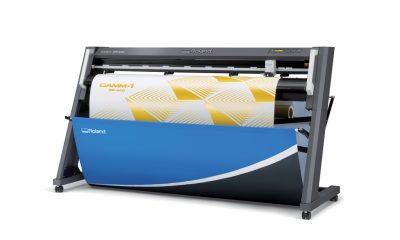Graphics Printing
Published
21 years agoon
A recent economic survey showed that a large percentage of graphics screen printers are working on very tight margins. So what’s new? Tight margins have been a reality for years as graphics printers have struggled with the ups and downs caused by changing market conditions and tried to keep up with the latest digital and screen-printing technologies. Rather than burying themselves in gloom when market conditions are at their worst, many printers are swept along by a perceived need to spend serious amounts of money on technology, aiming to use this investment to gain market share.
A recent economic survey showed that a large percentage of graphics screen printers are working on very tight margins. So what’s new? Tight margins have been a reality for years as graphics printers have struggled with the ups and downs caused by changing market conditions and tried to keep up with the latest digital and screen-printing technologies. Rather than burying themselves in gloom when market conditions are at their worst, many printers are swept along by a perceived need to spend serious amounts of money on technology, aiming to use this investment to gain market share. This is a noble goal, provided that the company doesn’t lose sight of its main objective–profitability.
This magazine has readers on several continents who represent print shops ranging from two-man operations to multinational corporations. In every one of these businesses, the aim is the same: generate profits, and the more the better. What isn’t the same is how those profits are used or distributed, which varies with the management philosophy of those who run each organization. But no matter what attitude management holds, looking inward for ways to increase profitability is critical to the overall health of any company.
Conventional wisdom
"Get more sales, reduce prices, explore other markets, buy new equipment, search for grants–we have got to do something to improve our financial position!" Statements like this are made in screen-printing businesses everywhere. Such companies pursue the path of increased market share, investing in more sophisticated equipment and achieving–if they are fortunate–high growth in order volume. The problem is that they still maintain a low profitability.
The opposite scenario is when profitability is maintained or increased, but market share reduces. This means that the company may simply fade quietly away. Finding the balance between these two extremes should be the goal of every screen-printing operation.
Nobody in the industry needs to be told that times are tough–this fact is clear to everyone. But what can we do about it? Traditionally if times are slack, machines and walls get painted, parking lots are weeded, and maybe equipment is serviced. For those with an accountant’s mentality, such times bring about talk of reducing overhead, staff cutbacks, and rescheduling debt. But those of us with the engineer’s mindset will direct our efforts toward improving the performance of the company and the processes it employs.
A positive approach
As with many situations in life, screen-printing businesses need to look inwards to achieve the greatest gains. A company is just like a living organism–it develops patterns of behavior, some of which are good, others that are bad. By contemplating how all the systems in your organization work individually and together, you can start to make adjustments that will lead to real gains in profitability. And you don’t have to be an accountant to do it. All you need is eyes, ears, experience, willingness to suspend judgement and remain objective, and the ability to regularly ask the question "Why?" Oh, and one more thing–never make assumptions.
The goal in this exercise is to consider small modifications you can make to systems, procedures, and workflows, enhancing work methods and conditions to improve efficiency, which will translate into increased profits. For example, if your typical reject rate is 5% of your output, and you reduce rejects to 4%, you’ve just improved your reject rate by 20%. Focusing on these sorts of improvements add up quickly in savings and, inevitably, profits.
To find opportunities for improving your business, start by booking a day off. On this day, you are not available. Switch off your mobile phone, and give instructions to the receptionist that you are not to be contacted. Then go into work.
Start to walk the floor of your operation. Begin in shipping and continue through to finishing and production into art and order collection. Include all departments, except the commercial sections of sales and administration. They will be left for another day. You will see the process in reverse, which will make you less likely to be caught up in the flow of assumptions that you make daily.
You will take notes throughout your journey as you look, question, and listen. Your aim is to discover leaks in the production pipeline. Don’t expect to find areas where profits are being drained in a torrent; instead, focus on the cracks and drips that are incurring extra costs and reducing your margins of productivity and efficiency.
You’ll repeat the walk several times. On your first trip through the facility, just look and absorb what you see. Imagine you are the most persnickety customer your company deals with and seeing the facility for the first time. Don’t forget to smile and exchange pleasantries with the staff, because your people will help save you a great deal of money by the end of the day. During the first circuit, tell the supervisors or line managers that you will come around again and will talk to them and their staff. Make notes of impressions that you gain during this preparatory viewing. First impressions are very useful.
Remember the simple fact that your very presence on the production floor may alter the behavior of workers. You will have to take this into account as you assess the operation.
Your initial impressions will help you identify areas that need particular attention on your next circuit. This time as you make the walk, stop to talk to the people doing the work. Do the job descriptions of workers match the functions that they perform? If not, why? Could their job instructions and performance be improved? What prevents them from performing their functions more efficiently? It may be something simple like a tape dispenser not working or a knife being too dull. Perhaps the room is too cold or too hot. Perhaps discomfort from poor seating or lack of shock-absorbing floor mats is slowing them down. Or maybe their work area is poorly organized. Could they benefit from shelving or storage space at their work site to facilitate rapid replenishment of the production supplies they use? Is the tie up caused by paperwork that could be simplified or processed automatically? What are the simple things you can do to make everyone work easier, smarter, and more effectively?
Screen printing is best performed as a clean process. If your production area is dirty, you are essentially hemorrhaging profits. An unclean workplace leads to dirty substrates, pinholes in stencils, pinholes in prints, contaminated inks, UV-curing units with dirty reflectors, the need to use solvent-based cleaners excessively, increased waste disposal costs, a surplus of health and safety issues, high reject levels, increased downtime, and other negative side effects.
For healthy profitability in this competitive era, your business needs to adopt a zero-defect mentality. Don’t kid yourself into believing a particular reject rate is acceptable because it "used to be worse." Those days are long past. Also note that we’re talking about eliminating rejects in-house. Rejects that make it as far as the customer are unthinkable.
Machine downtime is another killer of profitability. Look at your machine-operating times and calculate the capacity of output they should be delivering. Ideally, the figure should match the production number your plant actually achieves. However, you’ll probably find that there will be a significant difference, with far less product being generated than should be.
When you purchased the machine, you were quoted production rates of 600 parts/hr. But your own output figures show 300 parts/hr. What is stealing all this productivity? Chances are that when you consider the process carefully, you’ll find the downtime results from ink drying in screen that requires cleaning of the stencil, squeegee changeovers, adjustments to substrate position, corrections to registration, ink adjustments, off-contact adjustments, and more. All these conditions create downtime. But by standardizing procedures and keeping accurate production records, the problems can be eliminated.
Just do it
Before you even consider buying new equipment, you need to put your house in order. You’ll likely find that your productivity and profitability problems have very little to do with deficiencies in your current equipment. Rather, the problems will probably stem from failures in organization and technique. Improved housekeeping by itself can eliminate the vast majority of these conditions.
If you don’t have the time to perform a thorough analysis of your operation, hire an outside expert to handle the investigation for you. The simple fact is that without assessing and refining the fundamental functions of your company, profitability will continue to be an elusive goal.

Subscribe

Magazine
Get the most important news
and business ideas from Screenprinting Magazine.
Most Popular
-

 Case Studies2 months ago
Case Studies2 months agoHigh-Density Inks Help Specialty Printing Take Center Stage
-

 Art, Ad, or Alchemy2 months ago
Art, Ad, or Alchemy2 months agoF&I Printing Is Everywhere!
-

 Andy MacDougall2 months ago
Andy MacDougall2 months agoFunctional and Industrial Printing is EVERYWHERE!
-

 Columns3 weeks ago
Columns3 weeks ago8 Marketing Mistakes Not to Make When Promoting Your Screen Printing Services Online
-

 Editor's Note2 weeks ago
Editor's Note2 weeks agoLivin’ the High Life
-

 Marshall Atkinson2 weeks ago
Marshall Atkinson2 weeks agoHow to Create a Winning Culture in Your Screen-Printing Business
-

 Thomas Trimingham2 months ago
Thomas Trimingham2 months ago“Magic” Marketing for Screen Printing Shops
-

 News & Trends1 month ago
News & Trends1 month agoWhat Are ZALPHAS and How Can You Serve Them in Your Print Business?






